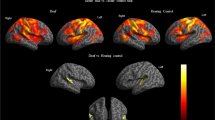Summary
In 46 isolated and 4in situ preparations of perioral skin, afferent impulse patterns, leading from cutaneous mechanoreceptors and responding to orthogonal square as well as sine-wave stimuli, were investigated in selachians (Scyliorhinus canicula).
-
1.
Two distinct classes of specific mechanoreceptors could be differentiated: pressure- and tension-sensitive units, excited only in either the pressure or the tension phase of standard steps. Both populations yielded PD-transfer functions with predominating D-components and slow adaptation. The pressure units (majority of trigeminal skin afferents) usually revealed lower thresholds than the tension type.
-
2.
Receptive areas (with a considerable portion of overlapping) and local discrimination thresholds were determined. A comparison with values of the dorsolateral region showed a twofold higher sensitivity in perioral skin. Several response parameters, such as overshoot and latency, were proved to be a function of the distance between focus and stimulus, as well as of the hydromechanical pressure bias of the skin.
-
3.
Under biologically relevant conditions, the focal transformation characteristics and amplitude-frequency responses of 78 cutaneous afferents were measured for low-frequency vibration. Increasing skin pressure resulted in a significant amplitude and frequency shift of different synchronization thresholds.
-
4.
In addition to specific responses, afferent discharges of unspecific units, sensitive to touch as well as cold, were also recorded. Most of these fibres revealed spontaneous activity, which could be modulated by superimposed mechanical stimulation.
Similar content being viewed by others
References
Adrian, E.D., Cattell, McK., Hoagland, H.: Sensory discharges in single cutaneous nerve fibres. J. Physiol. (Lond.)72, 377–391 (1931)
Békésy, G.v.: Über die Stärke der Vibrationsempfindung und ihre objektive Messung. Akust.Z.5, 113–124 (1940)
Dijkgraaf, S.: Biological significance of the lateral line organs. In: Lateral line detectors (ed. P. Cahn), pp. 83–95. Bloomington-London: Indiana University Press 1967
Fitzgerald, O.: Discharges from the sensory organs of the cat's vibrissae and the modification in their activity by ions. J. Physiol. (Lond.)98, 163–178 (1940)
Frisch, K.v., Stetter, H.: Untersuchungen über den Sitz des Gehörsinnes bei der Elritze. Z. vergl. Physiol.17, 686–801 (1932)
Gierke, H.E.v., Oestreicher, H.L., Franke, E.K., Parrack, H.O., Wittern, W.W.v.: Physics of vibrations in living tissues. J. appl. Physiol.4, 886–900 (1952)
Hensel, H.: Quantitative Beziehungen zwischen Temperaturreiz und Aktionspotentialen der Lorenzinischen Ampullen. Z. vergl. Physiol.37, 509–526 (1955)
Hensel, H., Boman, K.: Afferent impulses in cutaneous sensory nerves in human subjects. J. Neurophysiol.23, 564–578 (1960)
Hensel, H., Zotterman, Y.: The responses of mechanoreceptors to thermal stimulation. J. Physiol. (Lond.)115, 16–24 (1951)
Hoagland, H.: Specific nerve impulses from gustatory and tactile receptors in catfish. J. gen. Physiol.16, 685–694 (1933a)
Hoagland, H.: Electrical responses from the lateral-line nerves of catfish. I. J. gen. Physiol.16, 695–714 (1933b)
Hodgkin, A.L., Katz, B.: The effect of sodium ions on the electrical activity of the giant axon of the squid. J. Physiol. (Lond.)108, 37–77 (1949)
Hunt, C.C.: On the nature of vibration receptors in the hind limb of the cat. J. Physiol. (Lond.)155, 175–186 (1961)
Iggo, A.: An electrophysiological analysis of afferent fibres in primate skin. Acta neuroveg. (Wien)24, 225–240 (1963)
Keidel, W.D.: Aktionspotentiale des N. dorsocutaneus bei niederfrequenter Vibration der Froschrückenhaut. Pflügers Arch. ges. Physiol.260, 416–436 (1955)
Keidel, W.D.: Vibrationsreception. Der Erschütterungssinn des Menschen. Erlanger Forschungen, Reihe B: Naturwissenschaften, Bd. 2. Erlangen: Univ.-Bibliothek 1956
Keidel, W.D.: Grundprinzipien der akustischen und taktilen Informationsverarbeitung. Ergebn. Biol.24, 213–246 (1961)
Keidel, W.D.: Electrophysiology of vibratory perception. In: Contributions to sensory physiology, Vol. III (ed. W.D. Neff), pp. 1–79. New York-London: Academic Press 1968
Lissmann, H.W.: The neurological basis of the locomotory rhythm in the spinal dogfish (Scyllium canicula, Acanthias vulgaris). I. Reflex behaviour. J. exp. Biol.23, 143–161 (1946)
Lowenstein, O.: Pressure receptors in the fins of the dogfish,Scyliorhinus canicula. J. exp. Biol.33, 417–421 (1956)
Moulton, J.M.: Swimming sounds and the schooling of fishes. Biol. Bull.119, 210–223 (1960)
Nier, K.: Elektrodynamischer Mikrovibrator zur Applikation verschiedener Schwingungsformen in der Receptorphysiologie. Wiss. Kongr. Ref. Bd. Medizin-Technik, Stuttgart 1972
Nier, K., Hensel, H.: Amplitude- and phase-frequency response of cutaneous mechanoreceptors in selachians. Pflügers Arch. ges. Physiol.359, R96 (1975)
Oestreicher, H.L.: On the theory of propagation of mechanical vibration in human and animal tissues. USAF. Techn. Rep. No. 6244, United States Air Force, Air Material Command Nov. 1950
Oestreicher, H.L.: Field and impedance of an oscillating sphere in a viscoelastic medium with an application to biophysics. J. acoust. Soc. Amer.23, 707–714 (1951)
Späth, M.: Die Wirkung der Temperatur auf die Mechanoreceptoren des KnochenfischesLeuciscus rutilus L. Z. vergl. Physiol.56, 431–462 (1967)
Whitear, M.: The innervation of the skin in teleost fishes. Quart. J. micr. Sci.93, 289–305 (1952)
Witt, I., Hensel, H.: Afferente Impulse aus der Extremitätenhaut der Katze bei thermischer und mechanischer Reizung. Pflügers Arch. ges. Physiol.268, 582–596 (1959)
Wunderer, H.: Über Terminalkörperchen der Anamnier. Arch. mikr. Anat.71, 504–569 (1908)
Author information
Authors and Affiliations
Additional information
Supported by the Deutsche Forschungsgemeinschaft
The experiments were performed at the Biologische Anstalt Helgoland. We wish to thank Prof. Dr. O. Kinne and Dr. W. Greve for their hospitality and support, and Mrs. R. Bartels for her technical assistance.
Rights and permissions
About this article
Cite this article
Nier, K. Cutaneous sensitivity to touch and low-frequency vibration in selachians. J. Comp. Physiol. 109, 345–355 (1976). https://doi.org/10.1007/BF00663614
Received:
Issue Date:
DOI: https://doi.org/10.1007/BF00663614




